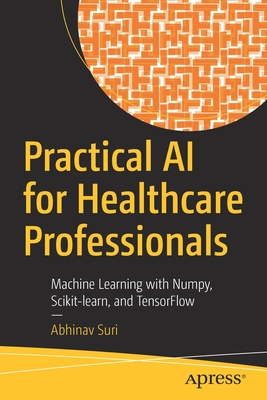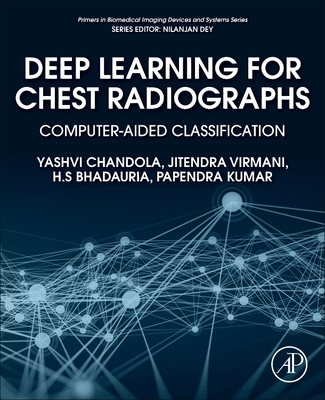商品描述
Radiological imaging is now accessible to a wide range of healthcare workers, many of whom are increasingly taking on extended roles. This book will equip all healthcare professionals, including medical students, chest physicians, radiographers and radiologists, with the techniques and knowledge required to interpret plain chest radiographs.
It is not an exhaustive text, but concentrates on interpretive skills and pattern recognition – these help the reader to understand the pitfalls and spot the clues that will allow them to correctly interpret the chest X-rays they will encounter in their daily practice.
The book features over 300 high quality images, along with a range of case story images designed to enable readers to test and develop their interpretation skills.
Interpreting Chest X-Rays is a handy ready reference that will help you to avoid making errors interpreting chest X-rays and decide, for example:
* if a temporary pacing wire has been inserted correctly
* whether the shadows you can see are real abnormalities
* if all chest tubes and lines are located appropriately in an ITU patient
* what further imaging may assist interpretation of an apparent abnormality
* whether a post-surgical chest is significantly abnormal
* what organism might be causing an infection
* why a patient is short of breath
* whether patient positioning accounts for an abnormal appearance on a chest X-ray
* what impact radiographic technique has had on the appearance of pathology
商品描述(中文翻譯)
放射影像學現在對於各類醫療工作者來說都變得更加可及,許多人正逐漸承擔起更擴展的角色。本書將為所有醫療專業人員,包括醫學生、胸腔科醫師、放射技術師和放射科醫師,提供解讀普通胸部X光片所需的技術和知識。
本書並不是一部詳盡的文本,而是專注於解讀技能和模式識別——這些有助於讀者理解常見的陷阱並找出線索,讓他們能夠正確解讀在日常實踐中遇到的胸部X光片。
本書包含超過300幅高品質影像,以及一系列案例故事影像,旨在幫助讀者測試和發展他們的解讀技能。
《解讀胸部X光片》是一部方便的參考書,將幫助您避免在解讀胸部X光片時出錯,並決定,例如:
* 暫時性心臟起搏導線是否正確插入
* 您所看到的陰影是否是真正的異常
* 所有胸腔引流管和導線是否在重症監護病人的適當位置
* 什麼進一步的影像檢查可能有助於解讀明顯的異常
* 手術後的胸部X光片是否顯著異常
* 可能引起感染的病原體是什麼
* 為什麼病人會感到呼吸急促
* 病人姿勢是否解釋了胸部X光片上的異常外觀
* 放射技術對病理外觀的影響
目錄大綱
1. Technique
1.1 Techniques available
2. Anatomy
2.1 Frontal CXR
2.2 Lateral CXR
2.3 Normal variants
3. In-built errors of interpretation
3.1 The eye-brain apparatus
3.2 The snapshot
3.3 Image misinterpretation
3.4 Satisfaction of search
3.5 Ignoring the ribs
4. The fundamentals of CXR interpretation
4.1 The silhouette sign
4.2 Suggested scheme for CXR viewing
4.3 Review areas
4.4 Pitfalls
5. Pattern recognition
5.1 Collapses
5.2 Ground glass opacity
5.3 Consolidation
5.4 Masses
5.5 Nodules
5.6 Lines
5.7 Cavities
6. Abnormalities of the thoracic cage and chest wall
6.1 Pectus excavatum
6.2 Scoliosis
6.3 Kyphosis
6.4 Bone lesions
6.5 Chest wall / thoracic inlet
6.6 Thoracoplasty
7. Lung tumours
7.1 CXR features of malignant tumours
7.2 CXR features of benign tumours
7.3 Metastases
7.4 Bronchial carcinoma
7.5 The solitary pulmonary nodule
8. Pneumonias
8.1 Pulmonary tuberculosis
8.2 Pneumococcal pneumonia
8.3 Staphylococcal pneumonia
8.4 Klebsiella pneumonia
8.5 Eosinophilic pneumonia
8.6 Opportunistic infections
9. Chronic airways disease
9.1 Asthma
9.2 Chronic bronchitis
9.3 Emphysema
9.4 Bronchiectasis
10. Diffuse lung disease
10.1 Interstitial disease - the reticular pattern
10.2 LAM
10.3 Langerhan's cell histiocytosis
10.4 Pulmonary sarcoid
10.5 Hypersensitivity pneumonitis
11. Pleural disease
11.1 Effusion
11.2 Pneumothorax
11.3 Pleural thickening
11.4 Pleural malignancy
11.5 Benign pleural tumours
12. Left heart failure
13. The heart and great vessels
13.1 Valve replacements
13.2 Cardiac enlargement
13.3 Ventricular aneurysm
13.4 Pericardial disease
13.5 Coarctation of the aorta
13.6 Aortic aneurysm
13.7 Atrial septal defect
13.8 Pacemakers
14. Pulmonary embolic disease
15. The mediastinum
15.1 The 'hidden' areas of the mediastinum
15.2 The hila
15.3 Stents
16. The ITU chest X-ray
16.1 Adult respiratory distress syndrome
16.2 The CXR following thoracic surgery
17. The story films
Further reading
Index
目錄大綱(中文翻譯)
1. Technique
1.1 Techniques available
2. Anatomy
2.1 Frontal CXR
2.2 Lateral CXR
2.3 Normal variants
3. In-built errors of interpretation
3.1 The eye-brain apparatus
3.2 The snapshot
3.3 Image misinterpretation
3.4 Satisfaction of search
3.5 Ignoring the ribs
4. The fundamentals of CXR interpretation
4.1 The silhouette sign
4.2 Suggested scheme for CXR viewing
4.3 Review areas
4.4 Pitfalls
5. Pattern recognition
5.1 Collapses
5.2 Ground glass opacity
5.3 Consolidation
5.4 Masses
5.5 Nodules
5.6 Lines
5.7 Cavities
6. Abnormalities of the thoracic cage and chest wall
6.1 Pectus excavatum
6.2 Scoliosis
6.3 Kyphosis
6.4 Bone lesions
6.5 Chest wall / thoracic inlet
6.6 Thoracoplasty
7. Lung tumours
7.1 CXR features of malignant tumours
7.2 CXR features of benign tumours
7.3 Metastases
7.4 Bronchial carcinoma
7.5 The solitary pulmonary nodule
8. Pneumonias
8.1 Pulmonary tuberculosis
8.2 Pneumococcal pneumonia
8.3 Staphylococcal pneumonia
8.4 Klebsiella pneumonia
8.5 Eosinophilic pneumonia
8.6 Opportunistic infections
9. Chronic airways disease
9.1 Asthma
9.2 Chronic bronchitis
9.3 Emphysema
9.4 Bronchiectasis
10. Diffuse lung disease
10.1 Interstitial disease - the reticular pattern
10.2 LAM
10.3 Langerhan's cell histiocytosis
10.4 Pulmonary sarcoid
10.5 Hypersensitivity pneumonitis
11. Pleural disease
11.1 Effusion
11.2 Pneumothorax
11.3 Pleural thickening
11.4 Pleural malignancy
11.5 Benign pleural tumours
12. Left heart failure
13. The heart and great vessels
13.1 Valve replacements
13.2 Cardiac enlargement
13.3 Ventricular aneurysm
13.4 Pericardial disease
13.5 Coarctation of the aorta
13.6 Aortic aneurysm
13.7 Atrial septal defect
13.8 Pacemakers
14. Pulmonary embolic disease
15. The mediastinum
15.1 The 'hidden' areas of the mediastinum
15.2 The hila
15.3 Stents
16. The ITU chest X-ray
16.1 Adult respiratory distress syndrome
16.2 The CXR following thoracic surgery
17. The story films
Further reading
Index





















